Anterior Capsule Opening Contraction and Late Intraocular Lens Dislocation after Cataract Surgery in Patients with Weak or Partially Absent Zonular Support
Abstract
1. Introduction
2. Materials and Methods
Statistical analysis
3. Results
4. Discussion
5. Conclusions
Author Contributions
Funding
Institutional Review Board Statement
Informed Consent Statement
Data Availability Statement
Acknowledgments
Conflicts of Interest
References
- Davis, D.; Brubaker, J.; Espandar, L.; Stringham, J.; Crandall, A.; Werner, L.; Mamalis, N. Late In-the-Bag Spontaneous Intraocular Lens Dislocation: Evaluation of 86 Consecutive Cases. Ophthalmology 2009, 116, 664–670. [Google Scholar] [CrossRef]
- Krepste, L.; Kuzmiene, L.; Miliauskas, A.; Januleviciene, I. Possible Predisposing Factors for Late Intraocular Lens Dislocation after Routine Cataract Surgery. Medicina (Kaunas) 2013, 49, 229–234. [Google Scholar] [PubMed]
- Subasi, S.; Yuksel, N.; Karabas, V.L.; Yilmaz Tugan, B. Late In-the-Bag Spontaneous IOL Dislocation: Risk Factors and Surgical Outcomes. Int. J. Ophthalmol. 2019, 12, 954–960. [Google Scholar] [CrossRef] [PubMed]
- Gross, J.G.; Kokame, G.T.; Weinberg, D.V. The Dislocated In-The-Bag Intraocular Lens Study Group In-the-Bag Intraocular Lens Dislocation. Am. J. Ophthalmol. 2004, 137, 630–635. [Google Scholar] [CrossRef] [PubMed]
- Clark, A.; Morlet, N.; Ng, J.Q.; Preen, D.B.; Semmens, J.B. Whole Population Trends in Complications of Cataract Surgery over 22 Years in Western Australia. Ophthalmology 2011, 118, 1055–1061. [Google Scholar] [CrossRef] [PubMed]
- Monestam, E. Frequency of Intraocular Lens Dislocation and Pseudophacodonesis, 20 Years After Cataract Surgery—A Prospective Study. Am. J. Ophthalmol. 2019, 198, 215–222. [Google Scholar] [CrossRef] [PubMed]
- Ostern, A.E.; Sandvik, G.F.; Drolsum, L. Late In-the-Bag Intraocular Lens Dislocation in Eyes with Pseudoexfoliation Syndrome. Acta Ophthalmol. 2014, 92, 184–191. [Google Scholar] [CrossRef]
- Lee, G.-I.; Lim, D.H.; Chi, S.A.; Kim, S.W.; Shin, D.W.; Chung, T.-Y. Risk Factors for Intraocular Lens Dislocation after Phacoemulsification: A Nationwide Population-Based Cohort Study. Am. J. Ophthalmol. 2020, 214, 86–96. [Google Scholar] [CrossRef]
- Kristianslund, O.; Raen, M.; Ostern, A.E.; Drolsum, L. Late In-the-Bag Intraocular Lens Dislocation: A Randomized Clinical Trial Comparing Lens Repositioning and Lens Exchange. Ophthalmology 2017, 124, 151–159. [Google Scholar] [CrossRef]
- Kocak Altintas, A.G.; Omay, A.E.; Celik, S. Spontaneous Late Intraocular Lens and Capsule Tension Ring Dislocation. Turk. J. Ophthalmol. 2017, 47, 106–109. [Google Scholar] [CrossRef]
- Vanags, J.; Laganovska, G. Long-Term Outcome of Cataract Surgery in Eyes with Pseudoexfoliation Syndrome Associated with Weak Zonules: A Case Report. Case Rep. Ophthalmol. 2020, 11, 54–59. [Google Scholar] [CrossRef] [PubMed]
- Davison, J.A. Capsule Contraction Syndrome. J. Cataract Refract. Surg. 1993, 19, 582–589. [Google Scholar] [CrossRef]
- Nishi, O.; Nishi, K. Intraocular Lens Encapsulation by Shrinkage of the Capsulorhexis Opening. J. Cataract Refract. Surg. 1993, 19, 544–545. [Google Scholar] [CrossRef]
- Zhu, X.-J.; Chen, M.-J.; Zhang, K.-K.; Yang, J.; Lu, Y. Elevated TGF-Beta2 Level in Aqueous Humor of Cataract Patients with High Myopia: Potential Risk Factor for Capsule Contraction Syndrome. J. Cataract Refract. Surg. 2016, 42, 232–238. [Google Scholar] [CrossRef]
- Cao, Q.; Xiao, B.; Jin, G.; Lin, J.; Wang, Y.; Young, C.A.; Lin, J.; Zhou, Y.; Zhang, B.; Cao, M.; et al. Expression of Transforming Growth Factor Beta and Matrix Metalloproteinases in the Aqueous Humor of Patients with Congenital Ectopia Lentis. Mol. Med. Rep. 2019, 20, 559–566. [Google Scholar] [CrossRef]
- Kawai, M.; Inoue, T.; Inatani, M.; Tsuboi, N.; Shobayashi, K.; Matsukawa, A.; Yoshida, A.; Tanihara, H. Elevated Levels of Monocyte Chemoattractant Protein-1 in the Aqueous Humor after Phacoemulsification. Investig. Ophthalmol. Vis. Sci. 2012, 53, 7951–7960. [Google Scholar] [CrossRef]
- Naumann, G.O.; Schlotzer-Schrehardt, U.; Kuchle, M. Pseudoexfoliation Syndrome for the Comprehensive Ophthalmologist. Intraocular and Systemic Manifestations. Ophthalmology 1998, 105, 951–968. [Google Scholar] [CrossRef]
- Shingleton, B.J.; Neo, Y.N.; Cvintal, V.; Shaikh, A.M.; Liberman, P.; O’Donoghue, M.W. Outcome of Phacoemulsification and Intraocular Lens Implantion in Eyes with Pseudoexfoliation and Weak Zonules. Acta Ophthalmol. 2017, 95, 182–187. [Google Scholar] [CrossRef]
- Nelson, L.B.; Maumenee, I.H. Ectopia Lentis. Surv. Ophthalmol. 1982, 27, 143–160. [Google Scholar] [CrossRef]
- Jarrett, W.H., II. Dislocation of the Lens. A Study of 166 Hospitalized Cases. Arch. Ophthalmol. 1967, 78, 289–296. [Google Scholar] [CrossRef]
- Khokhar, S.; Agrawal, S.; Gupta, S.; Gogia, V.; Agarwal, T. Epidemiology of Traumatic Lenticular Subluxation in India. Int. Ophthalmol. 2014, 34, 197–204. [Google Scholar] [CrossRef] [PubMed]
- Morris, B.; Cheema, R.A. Phacoemulsification Using Iris-Hooks for Capsular Support in High Myopic Patient with Subluxated Lens and Secondary Angle Closure Glaucoma. Indian J. Ophthalmol. 2006, 54, 267–269. [Google Scholar] [CrossRef] [PubMed]
- Sato, H.; Wada, Y.; Abe, T.; Kawamura, M.; Wakusawa, R.; Tamai, M. Retinitis Pigmentosa Associated with Ectopia Lentis. Arch. Ophthalmol. 2002, 120, 852–854. [Google Scholar] [PubMed]
- Bayyoud, T.; Bartz-Schmidt, K.U.; Yoeruek, E. Long-Term Clinical Results after Cataract Surgery with and without Capsular Tension Ring in Patients with Retinitis Pigmentosa: A Retrospective Study. BMJ Open 2013, 3, e002616. [Google Scholar] [CrossRef] [PubMed]
- Cionni, R.J.; Osher, R.H. Management of Profound Zonular Dialysis or Weakness with a New Endocapsular Ring Designed for Scleral Fixation. J. Cataract Refract. Surg. 1998, 24, 1299–1306. [Google Scholar] [CrossRef]
- Santoro, S.; Sannace, C.; Cascella, M.C.; Lavermicocca, N. Subluxated Lens: Phacoemulsification with Iris Hooks. J. Cataract Refract. Surg. 2003, 29, 2269–2273. [Google Scholar] [CrossRef]
- Thapa, B.B.; Agarwal, A.; Singh, R.; Gupta, P.C.; Ram, J. Phacoaspiration with a Cionni Ring versus Pars Plana Lensectomy, Vitrectomy and Sutureless Transscleral IOL Fixation in Pediatric Patients with a Subluxated Lens. Graefes Arch. Clin. Exp. Ophthalmol. 2016, 254, 901–909. [Google Scholar] [CrossRef]
- Vasavada, A.R.; Praveen, M.R.; Vasavada, V.A.; Yeh, R.-Y.; Srivastava, S.; Koul, A.; Trivedi, R.H. Cionni Ring and In-the-Bag Intraocular Lens Implantation for Subluxated Lenses: A Prospective Case Series. Am. J. Ophthalmol. 2012, 153, 1144–1153. [Google Scholar] [CrossRef]
- Kumar, D.A.; Agarwal, A.; Jacob, S.; Lamba, M.; Packialakshmi, S.; Meduri, A. Combined Surgical Management of Capsular and Iris Deficiency with Glued Intraocular Lens Technique. J. Refract. Surg. 2013, 29, 342–347. [Google Scholar] [CrossRef][Green Version]
- Cleary, C.; Lanigan, B.; O’Keeffe, M. Artisan Iris-Claw Lenses for the Correction of Aphakia in Children Following Lensectomy for Ectopia Lentis. Br. J. Ophthalmol. 2012, 96, 419–421. [Google Scholar] [CrossRef]
- Vanags, J.; Erts, R.; Laganovska, G. Anterior Capsulorhexis Opening Reduction after Cataract Surgery with Subluxated Lenses. Medicina (Kaunas) 2017, 53, 310–315. [Google Scholar] [CrossRef] [PubMed]
- Choi, M.; Lazo, M.Z.; Kang, M.; Lee, J.; Joo, C.-K. Effect of Number and Position of Intraocular Lens Haptics on Anterior Capsule Contraction: A Randomized, Prospective Trial. BMC Ophthalmol. 2018, 18, 78. [Google Scholar] [CrossRef] [PubMed]
- Hayashi, K.; Hayashi, H. Intraocular Lens Factors That May Affect Anterior Capsule Contraction. Ophthalmology 2005, 112, 286–292. [Google Scholar] [CrossRef] [PubMed]
- Hayashi, K.; Yoshida, M.; Hirata, A.; Hayashi, H. Anterior Capsule Relaxing Incisions with Neodymium:YAG Laser for Patients at High-Risk for Anterior Capsule Contraction. J. Cataract Refract. Surg. 2011, 37, 97–103. [Google Scholar] [CrossRef]
- Kim, S.Y.; Yang, J.W.; Lee, Y.C.; Kim, S.-Y. Effect of Haptic Material and Number of Intraocular Lens on Anterior Capsule Contraction after Cataract Surgery. Korean J. Ophthalmol. 2013, 27, 7–11. [Google Scholar] [CrossRef]
- Hayashi, K.; Hayashi, H.; Nakao, F.; Hayashi, F. Reduction in the Area of the Anterior Capsule Opening after Polymethylmethacrylate, Silicone, and Soft Acrylic Intraocular Lens Implantation. Am. J. Ophthalmol. 1997, 123, 441–447. [Google Scholar] [CrossRef]
- Corydon, C.; Lindholt, M.; Knudsen, E.B.; Graakjaer, J.; Corydon, T.J.; Dam-Johansen, M. Capsulorhexis Contraction after Cataract Surgery: Comparison of Sharp Anterior Edge and Modified Anterior Edge Acrylic Intraocular Lenses. J. Cataract Refract. Surg. 2007, 33, 796–799. [Google Scholar] [CrossRef]
- Sickenberg, M.; Gonvers, M.; van Melle, G. Change in Capsulorhexis Size with Four Foldable Loop-Haptic Lenses over 6 Months. J. Cataract Refract. Surg. 1998, 24, 925–930. [Google Scholar] [CrossRef]
- Park, T.K.; Chung, S.K.; Baek, N.H. Changes in the Area of the Anterior Capsule Opening after Intraocular Lens Implantation. J. Cataract Refract. Surg. 2002, 28, 1613–1617. [Google Scholar] [CrossRef]
- Sugimoto, Y.; Takayanagi, K.; Tsuzuki, S.; Takahashi, Y.; Akagi, Y. Postoperative Changes over Time in Size of Anterior Capsulorrhexis in Phacoemulsification/Aspiration. Jpn. J. Ophthalmol. 1998, 42, 495–498. [Google Scholar] [CrossRef]
- Kato, S.; Suzuki, T.; Hayashi, Y.; Numaga, J.; Hattori, T.; Yuguchi, T.; Kaiya, T.; Oshika, T. Risk Factors for Contraction of the Anterior Capsule Opening after Cataract Surgery. J. Cataract Refract. Surg. 2002, 28, 109–112. [Google Scholar] [CrossRef]
- Al-Kharashi, S.A.; Al-Obailan, M. Capsular Phimosis with Complete Occlusion of the Anterior Capsular Opening after Intact Continuous Curvilinear Capsulorrhexis. Saudi J. Ophthalmol. 2009, 23, 175–178. [Google Scholar] [CrossRef] [PubMed]
- Hayashi, K.; Hayashi, H.; Nakao, F.; Hayashi, F. Anterior Capsule Contraction and Intraocular Lens Decentration and Tilt after Hydrogel Lens Implantation. Br. J. Ophthalmol. 2001, 85, 1294–1297. [Google Scholar] [CrossRef] [PubMed]
- Jacob, S.; Agarwal, A.; Agarwal, A.; Agarwal, S.; Patel, N.; Lal, V. Efficacy of a Capsular Tension Ring for Phacoemulsification in Eyes with Zonular Dialysis. J. Cataract Refract. Surg. 2003, 29, 315–321. [Google Scholar] [CrossRef]
- Lee, D.H.; Lee, H.Y.; Lee, K.H.; Chung, K.H.; Joo, C.K. Effect of a Capsular Tension Ring on the Shape of the Capsular Bag and Opening and the Intraocular Lens. J. Cataract Refract. Surg. 2001, 27, 452–456. [Google Scholar] [CrossRef]
- Das, P.; Ram, J.; Brar, G.S.; Dogra, M.R. Results of Intraocular Lens Implantation with Capsular Tension Ring in Subluxated Crystalline or Cataractous Lenses in Children. Indian J. Ophthalmol. 2009, 57, 431–436. [Google Scholar] [CrossRef]
- Hayashi, H.; Hayashi, K.; Nakao, F.; Hayashi, F. Anterior Capsule Contraction and Intraocular Lens Dislocation in Eyes with Pseudoexfoliation Syndrome. Br. J. Ophthalmol. 1998, 82, 1429–1432. [Google Scholar] [CrossRef]
- Kato, S.; Oshika, T.; Numaga, J.; Hayashi, Y.; Oshiro, M.; Yuguchi, T.; Kaiya, T. Anterior Capsular Contraction after Cataract Surgery in Eyes of Diabetic Patients. Br. J. Ophthalmol. 2001, 85, 21–23. [Google Scholar] [CrossRef]
- Price, F.W.J.; Mackool, R.J.; Miller, K.M.; Koch, P.; Oetting, T.A.; Johnson, A.T. Interim Results of the United States Investigational Device Study of the Ophtec Capsular Tension Ring. Ophthalmology 2005, 112, 460–465. [Google Scholar] [CrossRef]
- Takimoto, M.; Hayashi, K.; Hayashi, H. Effect of a Capsular Tension Ring on Prevention of Intraocular Lens Decentration and Tilt and on Anterior Capsule Contraction after Cataract Surgery. Jpn. J. Ophthalmol. 2008, 52, 363–367. [Google Scholar] [CrossRef]
- Strenn, K.; Menapace, R.; Vass, C. Capsular Bag Shrinkage after Implantation of an Open-Loop Silicone Lens and a Poly(Methyl Methacrylate) Capsule Tension Ring. J. Cataract Refract. Surg. 1997, 23, 1543–1547. [Google Scholar] [CrossRef]
- Gunenc, U.; Kocak, N.; Ozturk, A.T.; Arikan, G. Surgical Management of Spontaneous In-the-Bag Intraocular Lens and Capsular Tension Ring Complex Dislocation. Indian J. Ophthalmol. 2014, 62, 876–878. [Google Scholar] [CrossRef] [PubMed]
- Cionni, R.J.; Osher, R.H.; Marques, D.M.V.; Marques, F.F.; Snyder, M.E.; Shapiro, S. Modified Capsular Tension Ring for Patients with Congenital Loss of Zonular Support. J. Cataract Refract. Surg. 2003, 29, 1668–1673. [Google Scholar] [CrossRef]
- Cheung, A.Y.; Price, J.M.; Heidemann, D.G.; Hart, J.C.J. Uveitis-Glaucoma-Hyphema Syndrome Caused by Dislocated Cionni Endocapsular Tension Ring. Can. J. Ophthalmol. 2018, 53, e213–e214. [Google Scholar] [CrossRef] [PubMed]
- Lin, H.; Tan, X.; Lin, Z.; Chen, J.; Luo, L.; Wu, X.; Long, E.; Chen, W.; Liu, Y. Capsular Outcomes Differ with Capsulorhexis Sizes after Pediatric Cataract Surgery: A Randomized Controlled Trial. Sci. Rep. 2015, 5, 16227. [Google Scholar] [CrossRef]
- Ye, H.; Zhang, J.; Qian, Y. Long-Term Follow-up of Neodymium:YAG Laser Anterior Capsulotomy for the Treatment of Anterior Capsular Phimosis. J. Int. Med. Res. 2018, 46, 3692–3697. [Google Scholar] [CrossRef]
- Hayashi, K.; Hirata, A.; Hayashi, H. Possible Predisposing Factors for In-the-Bag and out-of-the-Bag Intraocular Lens Dislocation and Outcomes of Intraocular Lens Exchange Surgery. Ophthalmology 2007, 114, 969–975. [Google Scholar] [CrossRef]
- Xiao, W.; Zhao, D.-X.; Xue, L.-Q. Rapid Bilateral Anterior Capsule Contraction Following High Myopic Cataract Surgeries: A Case Report. Int. J. Ophthalmol. 2011, 4, 207–209. [Google Scholar] [CrossRef]
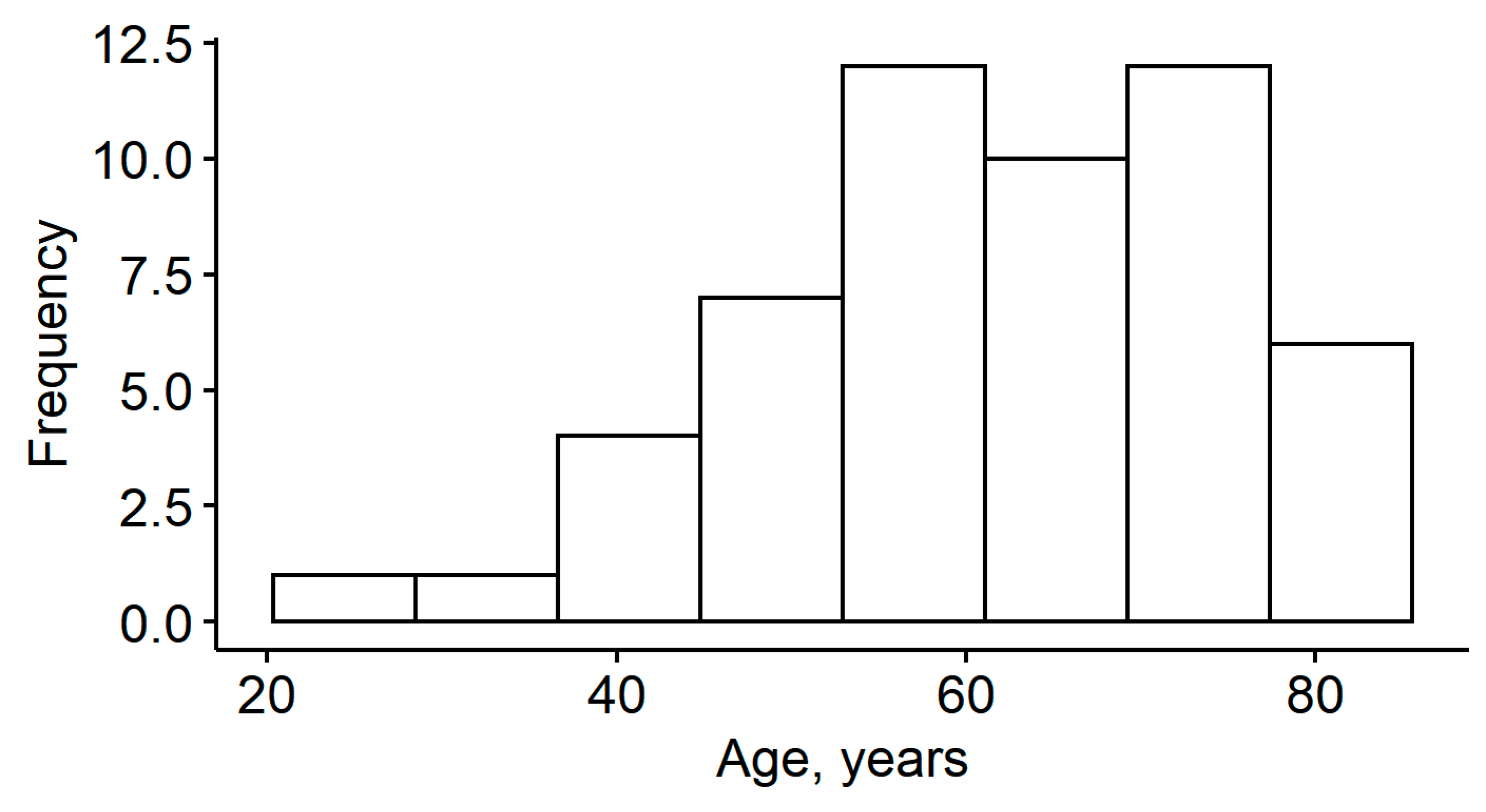
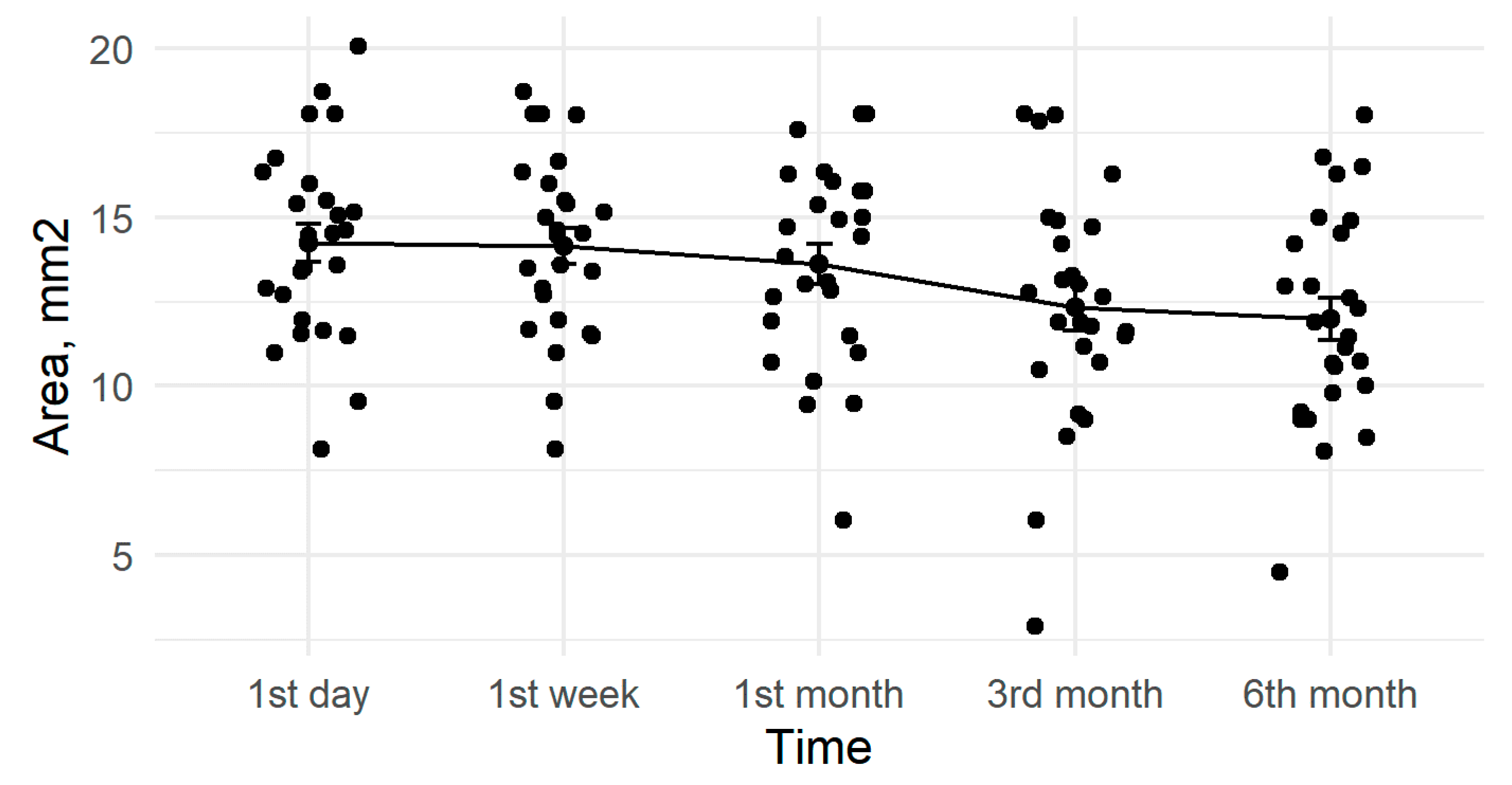
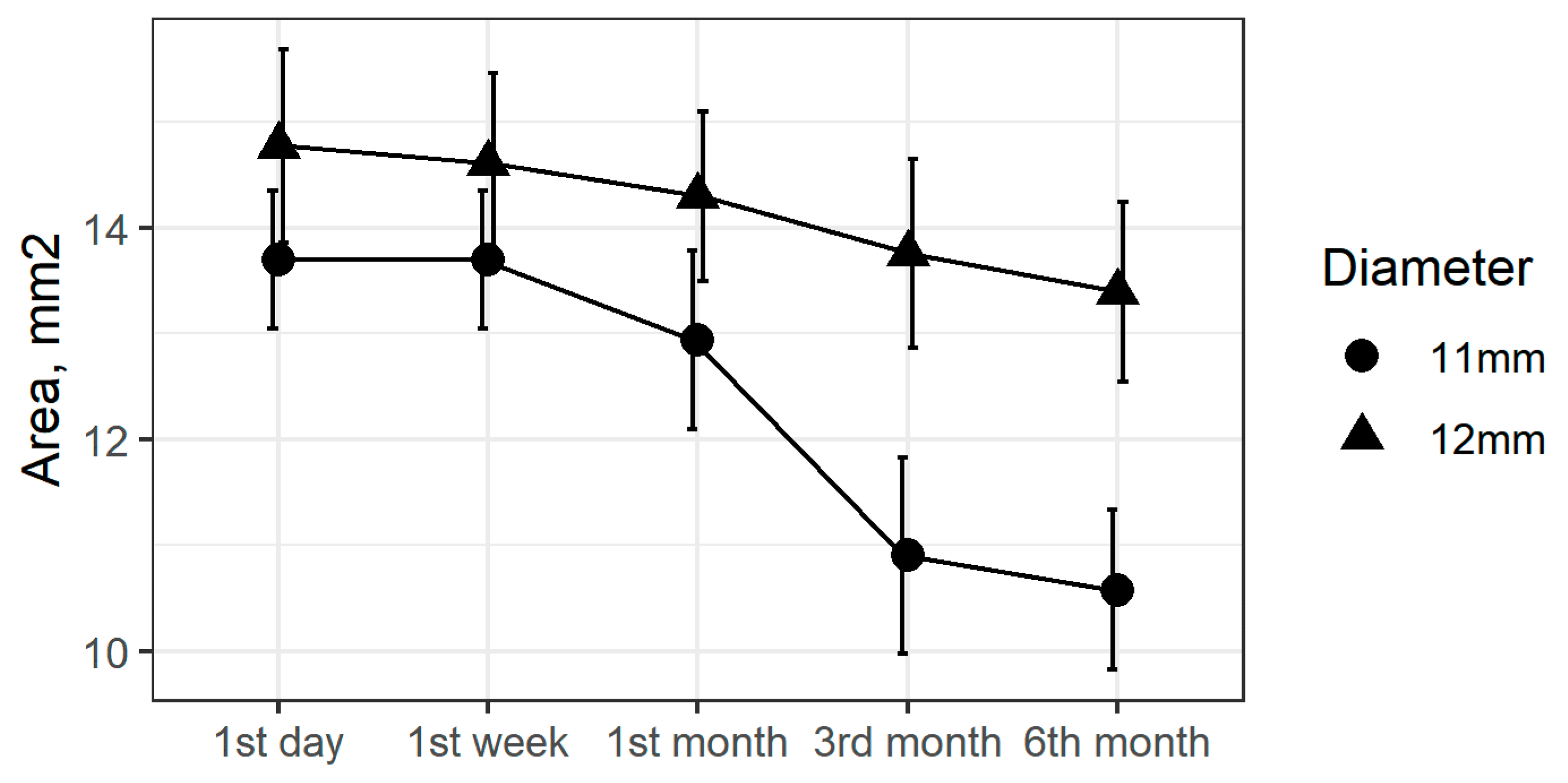
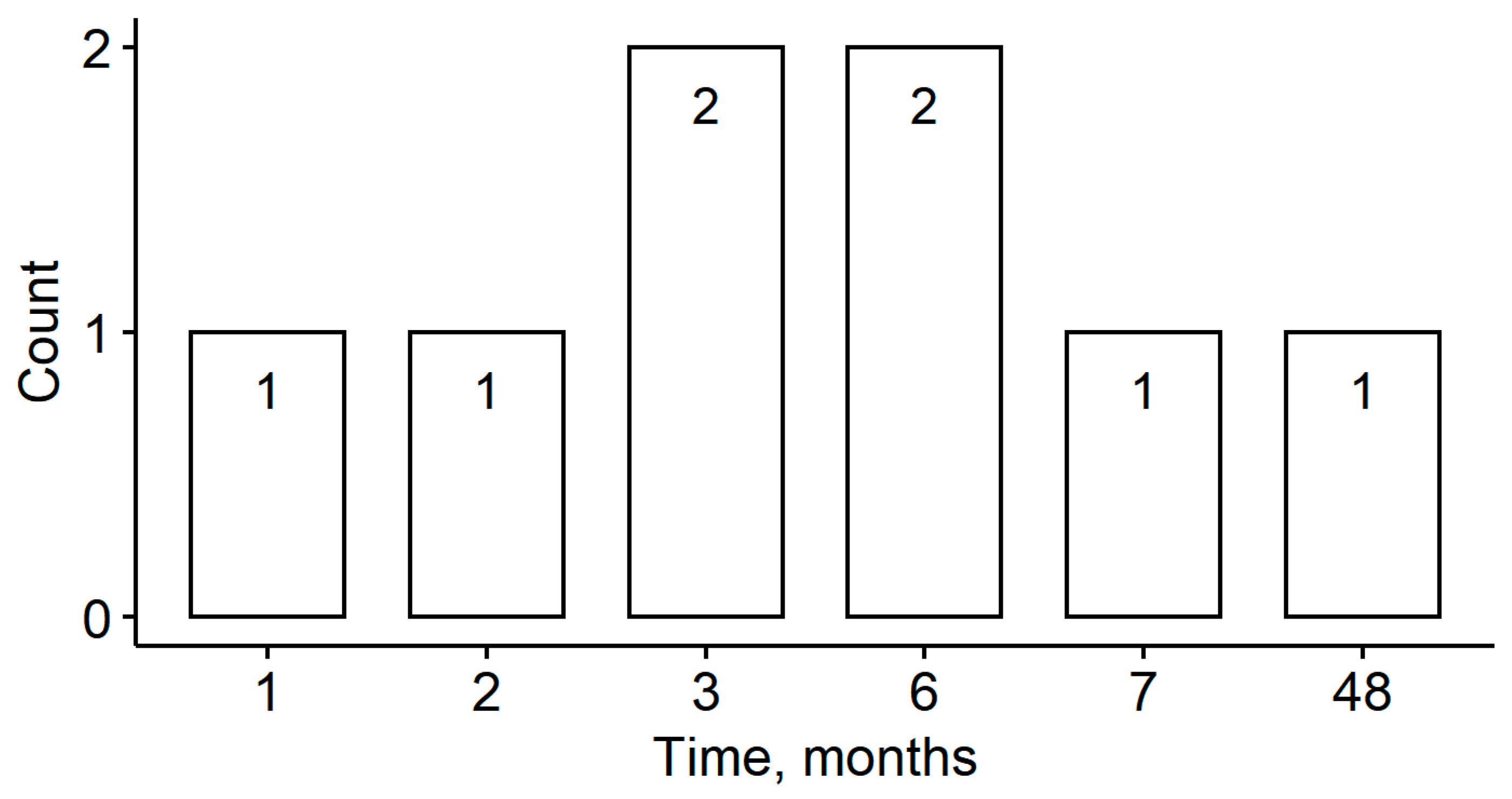
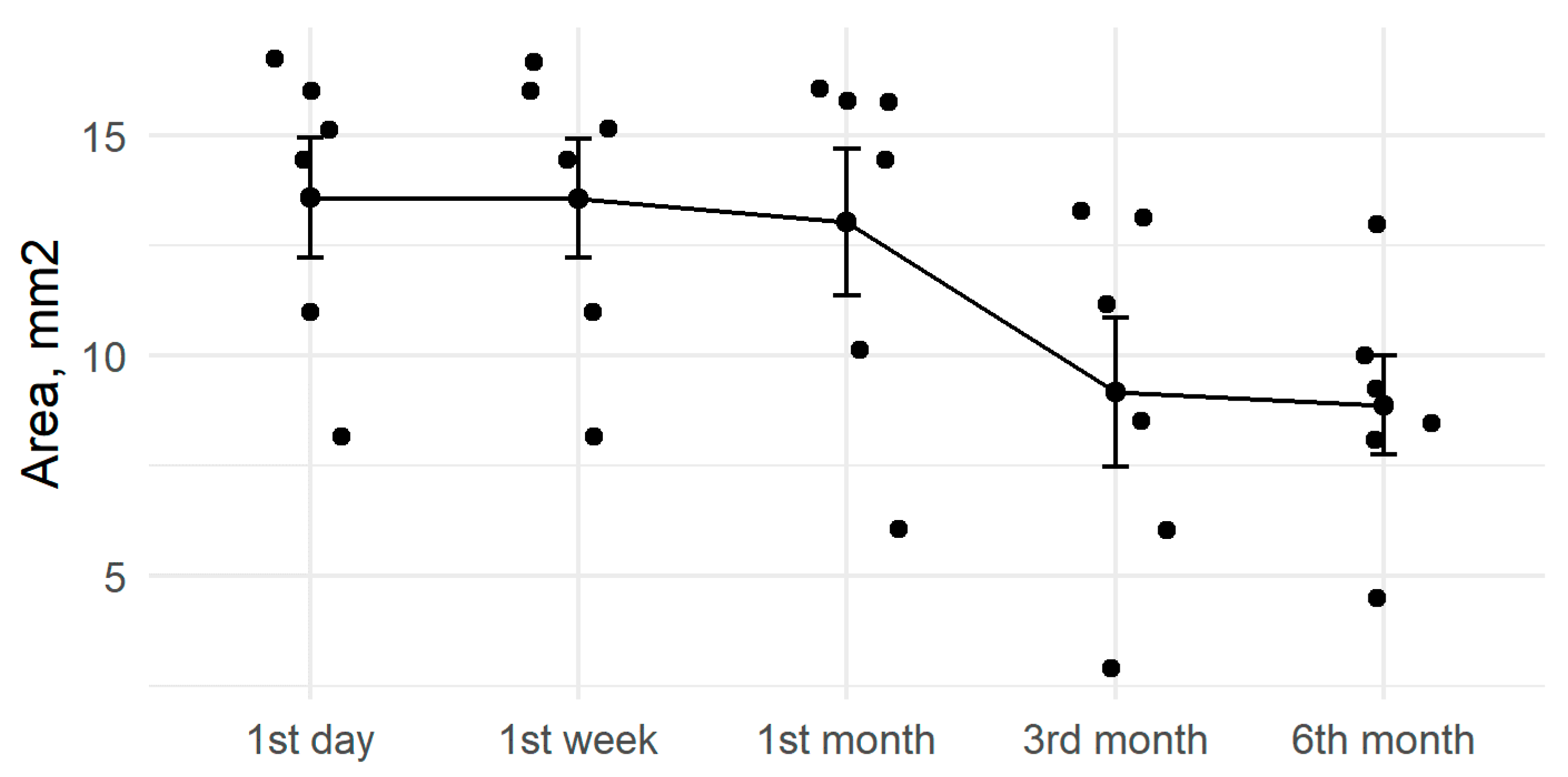
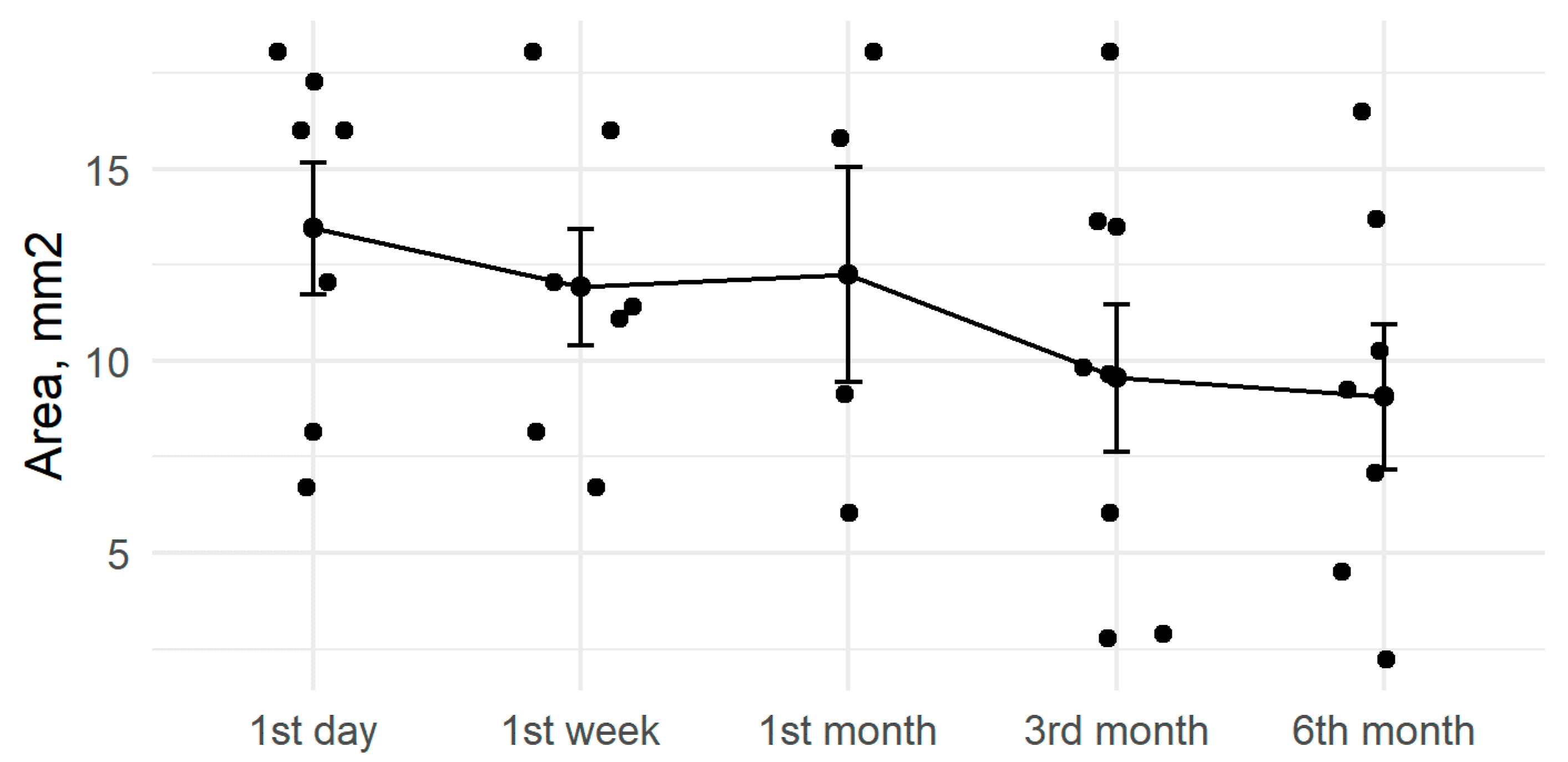
| Overall (N = 53) | p Value * | |
|---|---|---|
| Sex | ||
| Male | 41 (77.4%) | <0.001 |
| Female | 12 (22.6%) | |
| Implicated eye | ||
| Right eye | 22 (41.5%) | 0.27 (n.s.) |
| Left eye | 31 (58.5%) | |
| Glaucoma | ||
| No | 30 (56.6%) | 0.41 (n.s.) |
| Yes | 23 (43.4%) | |
| Myopia | ||
| No | 47 (88.7%) | <0.001 |
| Yes | 6 (11.3%) | |
| History of trauma | ||
| No | 36 (67.9%) | 0.01 |
| Yes | 17 (32.1%) | |
| Marfan syndrome | ||
| No | 50 (94.3%) | <0.001 |
| Yes | 3 (5.7%) | |
| PEX syndrome | ||
| No | 28 (52.8%) | 0.78 (n.s.) |
| Yes | 25 (47.2%) |
| Mean (SD) | p Value | |
|---|---|---|
| 1 day | 14.3 (3.68) | |
| 1 week | 14.2 (3.48) | |
| 1 month | 13.6 (3.80) | <0.001 |
| 3 months | 12.5 (4.45) | |
| 6 months | 12.1 (3.68) |
| Case No. (Study No) | Age during Primary Surgery (Yrs) | Gender | Time from Surgery to Dislocation (Yrs) | Predisposing Conditions (Diagnosis/Associated Presentation) | Type of CTR Implanted During Primary Surgery | Additional Manipulations | Outcome |
|---|---|---|---|---|---|---|---|
| 1 (N7) | 79 | Male | 7 | Blunt trauma | CTR | IOL-CTR-capsular bag removal, open loop IOL implantation in anterior chamber | |
| 2 (N9) | 48 | Female | 2 | Marfan syndrome | Modified CTR (Cionni), 2 fixation arms | Removal of IOL-CTR-capsular bag complex, aphakic | |
| 3 (N21) | 80 | Female | 3 | PEX | CTR | ACO contraction 2 months after initial surgery, Nd: YAG laser capsulotomy at this point | IOL-CTR-capsular bag reposition, endophthalmitis after reposition |
| 4 (N25) | 71 | Female | 5 | CTR | Posterior capsule o pacification (PCO) Nd: YAG posterior laser capsulotomy | IOL-CTR-capsular bag dropped in vitreous during exchange or reposition attempt, other clinic | |
| 5 (N26) | 74 | Male | 7 | PEX, glaucoma | CTR | ACO contraction 1 months after initial surgery, Nd: YAG laser anterior capsulotomy at this point | IOL-CTR-capsular bag exchange, open loop AC IOL implantation, other clinic |
| 6 (N40) | 49 | Female | 8 | Blunt trauma | CTR | PCO Nd: YAG posterior laser capsulotomy 3 months after surgery | IOL-CTR-capsular bag complex reposition |
| 7 (N50) | 77 | Male | 1 | Blunt trauma, PEX | CTR | IOL-CTR-capsular bag complex reposition |
Publisher’s Note: MDPI stays neutral with regard to jurisdictional claims in published maps and institutional affiliations. |
© 2021 by the authors. Licensee MDPI, Basel, Switzerland. This article is an open access article distributed under the terms and conditions of the Creative Commons Attribution (CC BY) license (http://creativecommons.org/licenses/by/4.0/).
Share and Cite
Vanags, J.; Erts, R.; Laganovska, G. Anterior Capsule Opening Contraction and Late Intraocular Lens Dislocation after Cataract Surgery in Patients with Weak or Partially Absent Zonular Support. Medicina 2021, 57, 35. https://doi.org/10.3390/medicina57010035
Vanags J, Erts R, Laganovska G. Anterior Capsule Opening Contraction and Late Intraocular Lens Dislocation after Cataract Surgery in Patients with Weak or Partially Absent Zonular Support. Medicina. 2021; 57(1):35. https://doi.org/10.3390/medicina57010035
Chicago/Turabian StyleVanags, Juris, Renārs Erts, and Guna Laganovska. 2021. "Anterior Capsule Opening Contraction and Late Intraocular Lens Dislocation after Cataract Surgery in Patients with Weak or Partially Absent Zonular Support" Medicina 57, no. 1: 35. https://doi.org/10.3390/medicina57010035
APA StyleVanags, J., Erts, R., & Laganovska, G. (2021). Anterior Capsule Opening Contraction and Late Intraocular Lens Dislocation after Cataract Surgery in Patients with Weak or Partially Absent Zonular Support. Medicina, 57(1), 35. https://doi.org/10.3390/medicina57010035





